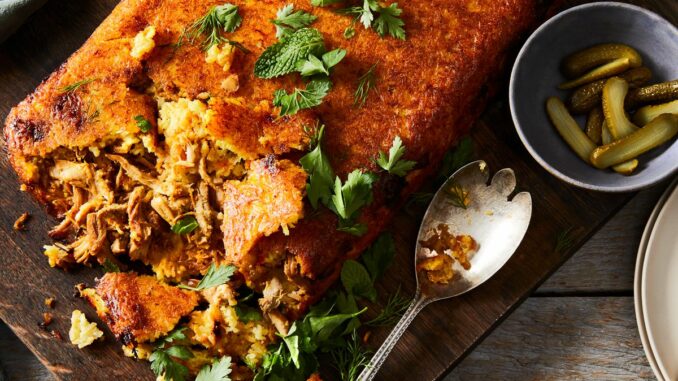
Tahchin, a delectable Persian rice dish, holds a significant place in Iranian cuisine, celebrated for its rich flavors, creamy texture, and beautiful presentation. This beloved dish, which translates to “bottom of the pot” in Persian, has a long history dating back centuries and remains a cherished part of Persian culinary tradition. In this extensive guide, we’ll explore the origins of Tahchin, its cultural significance, and provide a detailed recipe to recreate this delightful dish at home.
History and Cultural Significance
Tahchin’s origins can be traced back to ancient Persia, where it was enjoyed by kings and nobility as a luxurious delicacy. The dish is said to have been created in the royal kitchens of the Persian Empire, where skilled chefs crafted elaborate feasts fit for royalty. Tahchin was often prepared for grand banquets and special occasions, where it served as a symbol of opulence, refinement, and hospitality.
The name “Tahchin” refers to the crispy golden crust that forms at the bottom of the pot during cooking, which is one of the defining features of the dish. To achieve this coveted crust, layers of seasoned rice and other ingredients are carefully arranged in a pot and cooked over low heat, allowing the bottom layer to develop a crispy texture while the interior remains soft and creamy.
Over time, Tahchin became a cherished part of Persian cuisine, enjoyed by people of all backgrounds and generations. It is commonly served at weddings, celebrations, and family gatherings, where it is relished with delight and shared among loved ones. Beyond its culinary appeal, Tahchin holds deep cultural significance for Iranians, symbolizing warmth, tradition, and the bonds of family and community.
Recipe for Tahchin
Now, let’s explore a traditional recipe for Tahchin, featuring fragrant saffron-infused rice, tender chicken or lamb, and creamy yogurt:
Ingredients:
- 2 cups basmati rice
- 1 lb (450g) boneless chicken thighs or lamb, cut into chunks
- 2 cups plain yogurt
- 1 onion, thinly sliced
- 2 tablespoons butter or ghee
- 1/4 teaspoon ground saffron threads, dissolved in 2 tablespoons hot water
- 1/2 teaspoon ground turmeric
- 1/2 teaspoon ground cinnamon
- 1/4 teaspoon ground cardamom
- Salt and pepper to taste
- 2 tablespoons vegetable oil
Instructions:
- Rinse the basmati rice under cold water until the water runs clear. Soak the rice in cold water for 30 minutes to 1 hour, then drain well.
- In a large bowl, combine the plain yogurt with the dissolved saffron, ground turmeric, ground cinnamon, ground cardamom, salt, and pepper. Mix well to combine.
- Add the boneless chicken thighs or lamb chunks to the yogurt marinade, ensuring that the meat is evenly coated. Cover the bowl and refrigerate for at least 2 hours, or overnight for best results.
- In a large pot, heat the vegetable oil over medium heat. Add the thinly sliced onion and sauté until golden brown, about 5-7 minutes. Remove the onions from the pot and set aside.
- In the same pot, melt the butter or ghee over low heat. Add a layer of soaked basmati rice to the bottom of the pot, spreading it evenly.
- Arrange the marinated chicken thighs or lamb chunks on top of the rice in an even layer. Top with the sautéed onions.
- Add the remaining soaked basmati rice on top of the meat and onions, spreading it evenly to form a mound. Press down gently to compact the layers.
- Cover the pot with a tight-fitting lid and cook over low heat for 45-50 minutes, or until the rice is fully cooked and tender.
- Once the rice is cooked, remove the pot from the heat and let it rest for 5-10 minutes. Then, carefully invert the pot onto a serving platter to reveal the golden crust (tahdig) on the bottom.
- Slice the Tahchin into wedges and serve hot, garnished with fresh herbs and pomegranate seeds if desired.
Tips for Perfect Tahchin:
- Use high-quality basmati rice for the best results, as it has a long, slender grain and a fragrant aroma.
- Marinate the chicken thighs or lamb chunks in yogurt and spices for several hours or overnight to tenderize the meat and infuse it with flavor.
- Soak the rice in cold water before cooking to help prevent it from sticking together and ensure fluffy grains.
- Press down gently on the layers of rice and meat to compact them before cooking, which helps to create a firm and cohesive dish.
- Cook the Tahchin over low heat to allow the flavors to meld together and the bottom layer to develop a crispy golden crust.
Conclusion
Tahchin is more than just a dish; it’s a culinary masterpiece that embodies the rich flavors, heritage, and hospitality of Persian cuisine. From its ancient origins in the royal kitchens of Persia to its status as a beloved family recipe, Tahchin continues to captivate taste buds with its aromatic spices, creamy texture, and golden crust. Whether enjoyed at a festive celebration or a cozy family dinner, Tahchin brings people together to savor the vibrant tastes and shared traditions of Iranian culture. With its irresistible combination of tender meat, fragrant rice, and creamy yogurt, Tahchin is sure to delight and inspire food enthusiasts around the world.